Abstract
We have examined bacterial electroporation with a specific interest in the transformation of large DNA, i.e. molecules > 100 kb. We have used DNA from bacterial artificial chromosomes (BACs) ranging from 7 to 240 kb, as well as BAC ligation mixes containing a range o different sized molecules. The efficiency of electroporation with large DNA is strongly dependent on the strain of Escherichia coli used; strains which offer comparable efficiencies for 7 kb molecules differ in their uptake of 240 kb DNA by as much as 30-fold. Even with a host strain that transforms relatively well with large DNA, transformation efficiency drops dramatically with increasing size of the DNA. Molecules of 240 kb transform approximately 30-fold less well, on a molar basis, than molecules of 80 kb. Maximum transformation of large DNA occurs with different voltage gradients and with different time constants than are optimal for smaller DNA. This provides the opportunity to increase the yield of transformants which have taken up large DNA relative to the number incorporating smaller molecules. We have demonstrated that conditions may be selected which increase the average size of BAC clones generated by electroporation and compare the overall efficiency of each of the conditions tested.
Full text
PDF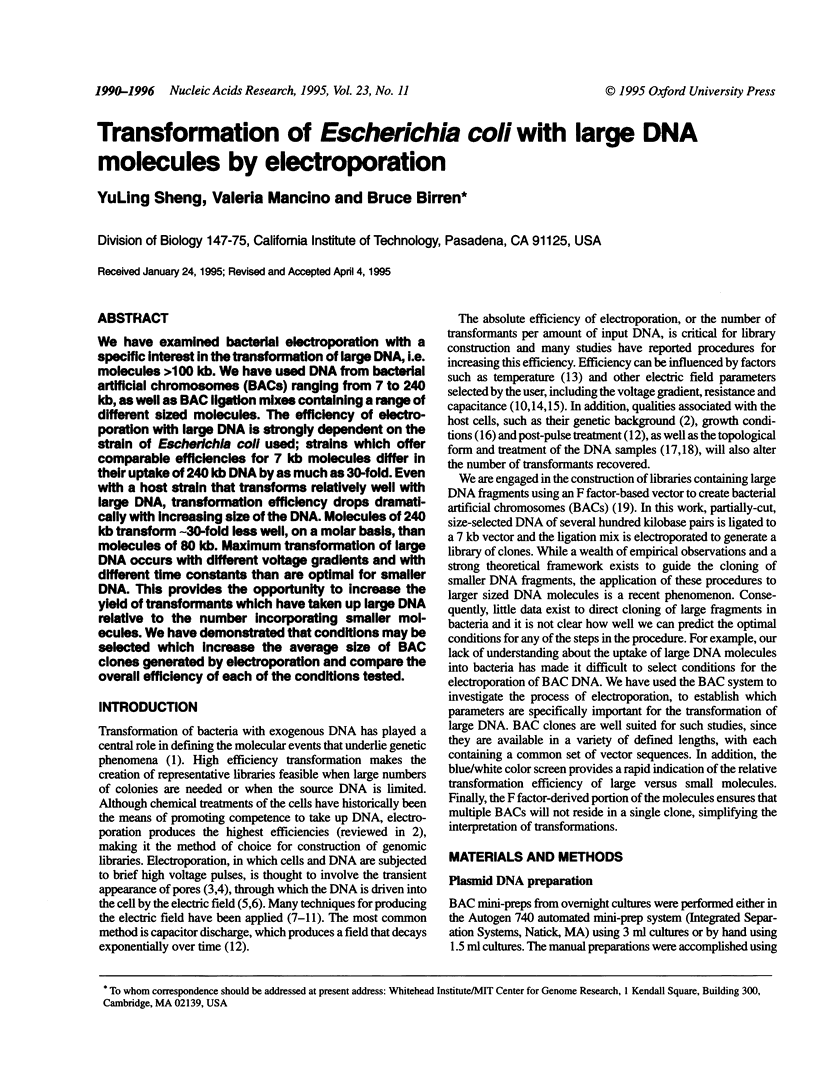
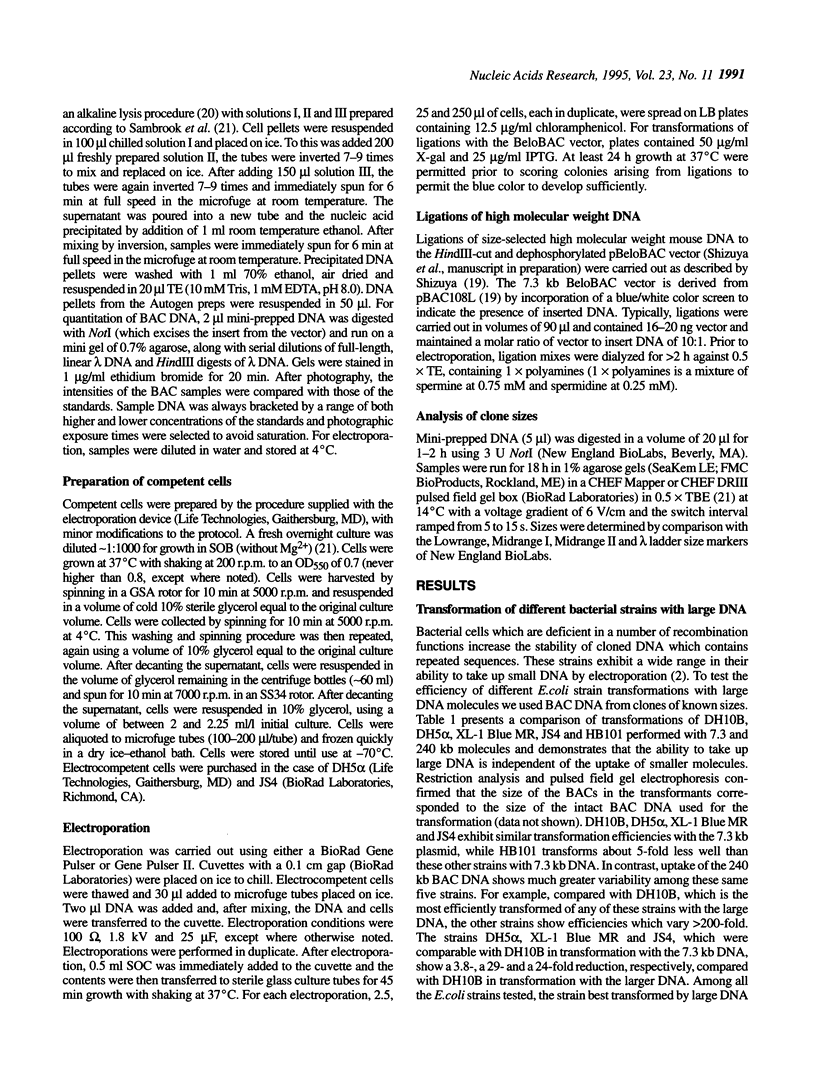
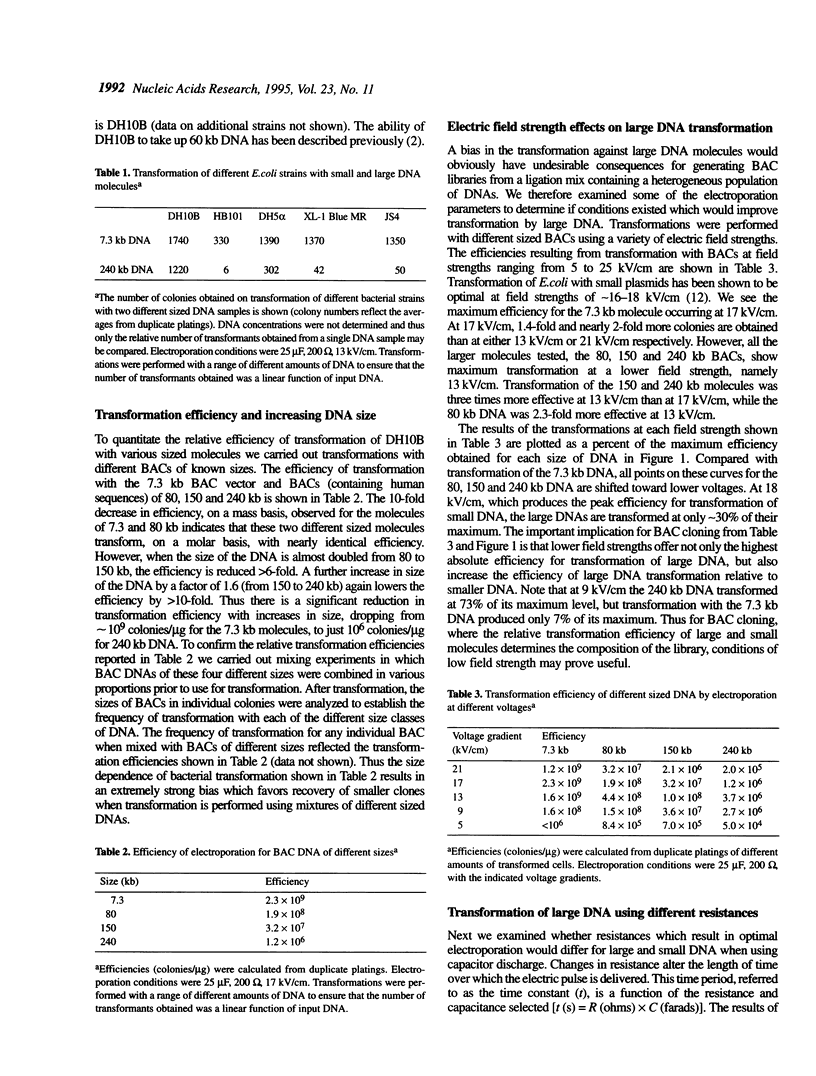
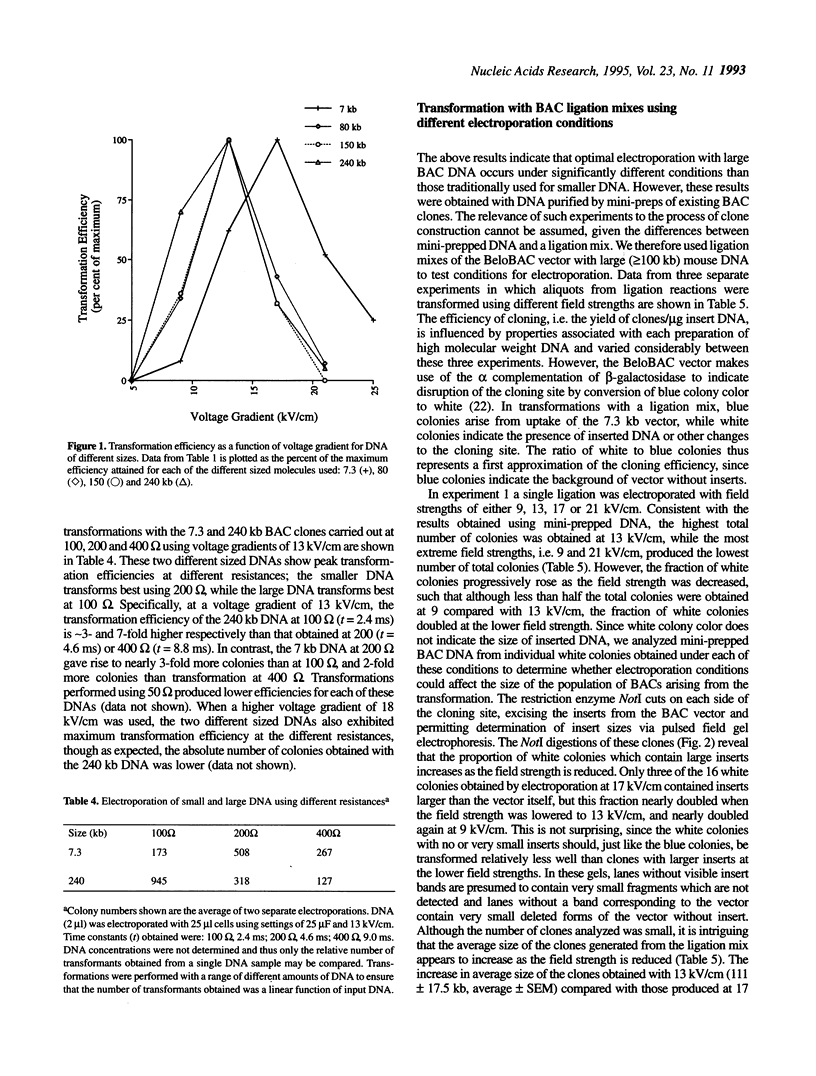
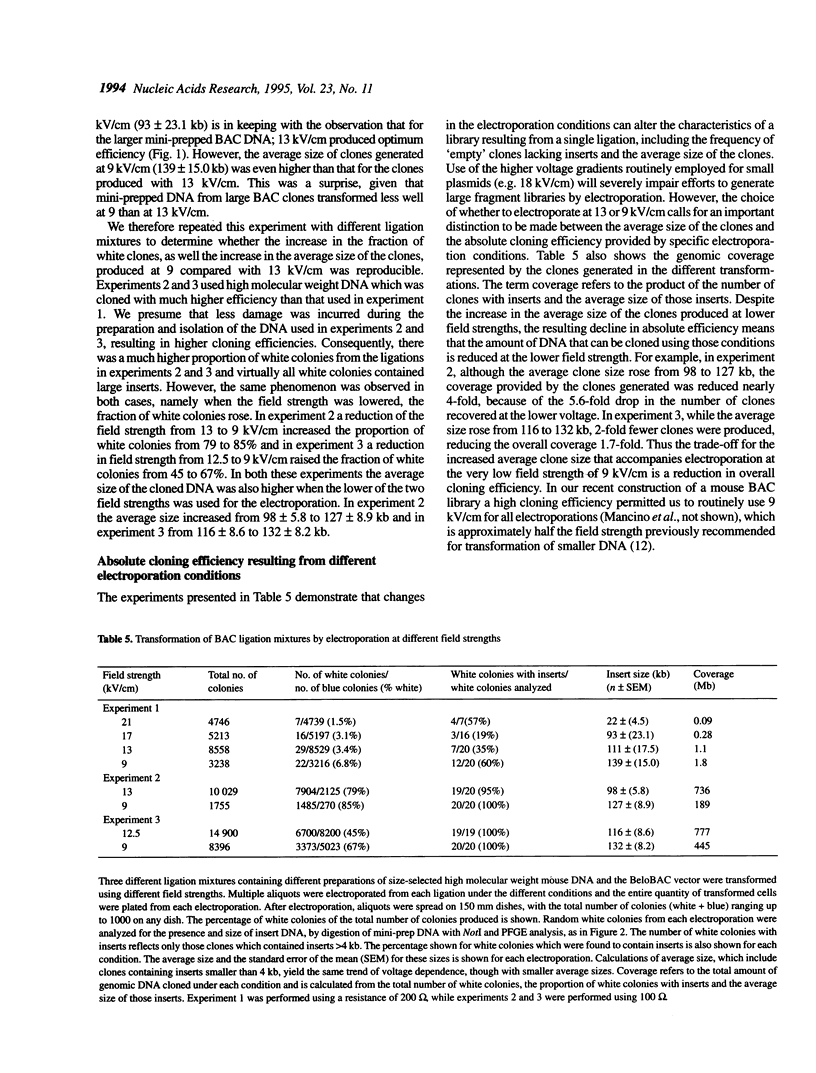
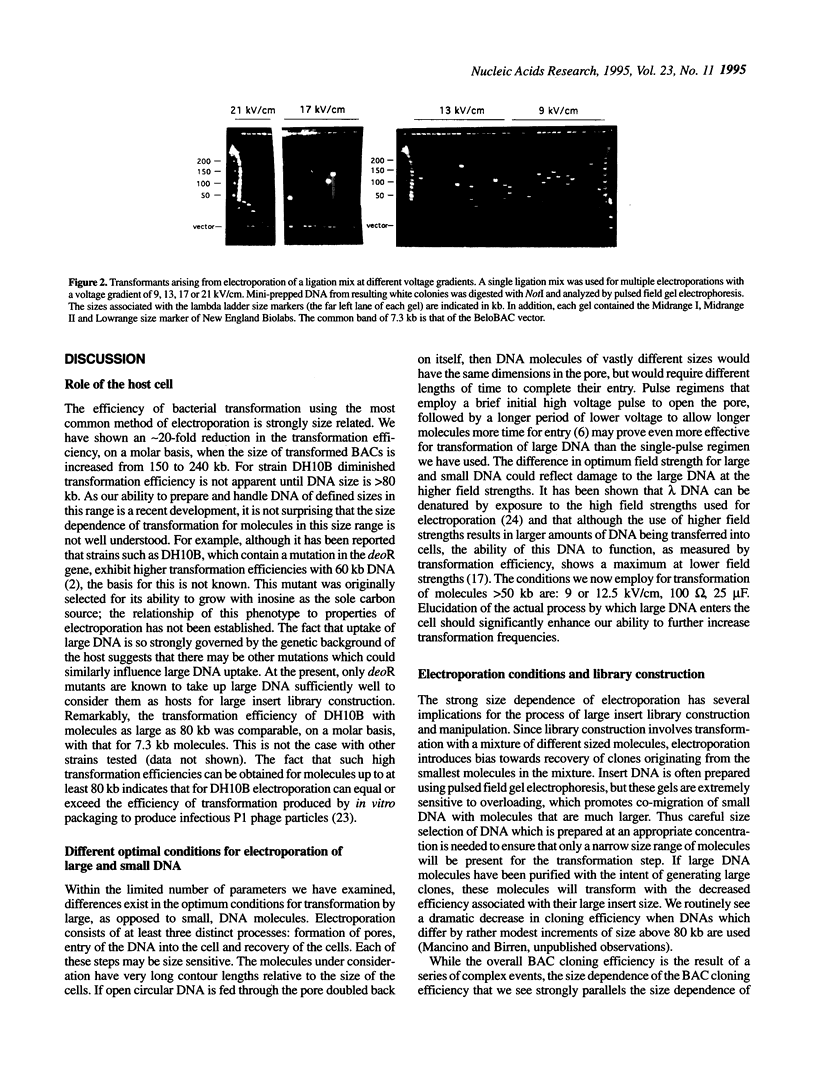
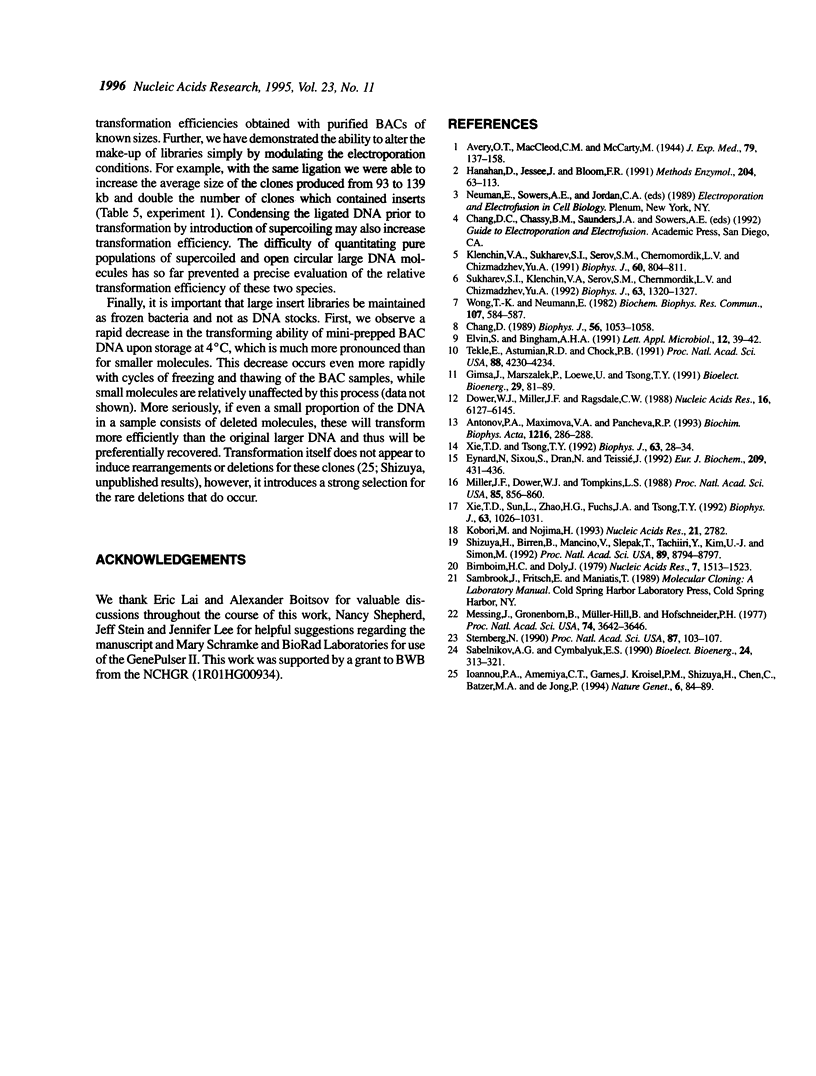
Images in this article
Selected References
These references are in PubMed. This may not be the complete list of references from this article.
- Antonov P. A., Maximova V. A., Pancheva R. P. Heat shock and osmotically dependent steps by DNA uptake after Escherichia coli electroporation. Biochim Biophys Acta. 1993 Nov 16;1216(2):286–288. doi: 10.1016/0167-4781(93)90155-7. [DOI] [PubMed] [Google Scholar]
- Birnboim H. C., Doly J. A rapid alkaline extraction procedure for screening recombinant plasmid DNA. Nucleic Acids Res. 1979 Nov 24;7(6):1513–1523. doi: 10.1093/nar/7.6.1513. [DOI] [PMC free article] [PubMed] [Google Scholar]
- Dower W. J., Miller J. F., Ragsdale C. W. High efficiency transformation of E. coli by high voltage electroporation. Nucleic Acids Res. 1988 Jul 11;16(13):6127–6145. doi: 10.1093/nar/16.13.6127. [DOI] [PMC free article] [PubMed] [Google Scholar]
- Elvin S., Bingham A. H. Electroporation-induced transformation of Escherichia coli: evaluation of a square waveform pulse. Lett Appl Microbiol. 1991 Feb;12(2):39–42. doi: 10.1111/j.1472-765x.1991.tb00498.x. [DOI] [PubMed] [Google Scholar]
- Eynard N., Sixou S., Duran N., Teissie J. Fast kinetics studies of Escherichia coli electrotransformation. Eur J Biochem. 1992 Oct 1;209(1):431–436. doi: 10.1111/j.1432-1033.1992.tb17306.x. [DOI] [PubMed] [Google Scholar]
- Farkas D. L., Wei M. D., Febbroriello P., Carson J. H., Loew L. M. Simultaneous imaging of cell and mitochondrial membrane potentials. Biophys J. 1989 Dec;56(6):1053–1069. doi: 10.1016/S0006-3495(89)82754-7. [DOI] [PMC free article] [PubMed] [Google Scholar]
- Hanahan D., Jessee J., Bloom F. R. Plasmid transformation of Escherichia coli and other bacteria. Methods Enzymol. 1991;204:63–113. doi: 10.1016/0076-6879(91)04006-a. [DOI] [PubMed] [Google Scholar]
- Ioannou P. A., Amemiya C. T., Garnes J., Kroisel P. M., Shizuya H., Chen C., Batzer M. A., de Jong P. J. A new bacteriophage P1-derived vector for the propagation of large human DNA fragments. Nat Genet. 1994 Jan;6(1):84–89. doi: 10.1038/ng0194-84. [DOI] [PubMed] [Google Scholar]
- Klenchin V. A., Sukharev S. I., Serov S. M., Chernomordik L. V., Chizmadzhev YuA Electrically induced DNA uptake by cells is a fast process involving DNA electrophoresis. Biophys J. 1991 Oct;60(4):804–811. doi: 10.1016/S0006-3495(91)82115-4. [DOI] [PMC free article] [PubMed] [Google Scholar]
- Kobori M., Nojima H. A simple treatment of DNA in a ligation mixture prior to electroporation improves transformation frequency. Nucleic Acids Res. 1993 Jun 11;21(11):2782–2782. doi: 10.1093/nar/21.11.2782. [DOI] [PMC free article] [PubMed] [Google Scholar]
- Messing J., Gronenborn B., Müller-Hill B., Hans Hopschneider P. Filamentous coliphage M13 as a cloning vehicle: insertion of a HindII fragment of the lac regulatory region in M13 replicative form in vitro. Proc Natl Acad Sci U S A. 1977 Sep;74(9):3642–3646. doi: 10.1073/pnas.74.9.3642. [DOI] [PMC free article] [PubMed] [Google Scholar]
- Miller J. F., Dower W. J., Tompkins L. S. High-voltage electroporation of bacteria: genetic transformation of Campylobacter jejuni with plasmid DNA. Proc Natl Acad Sci U S A. 1988 Feb;85(3):856–860. doi: 10.1073/pnas.85.3.856. [DOI] [PMC free article] [PubMed] [Google Scholar]
- Shizuya H., Birren B., Kim U. J., Mancino V., Slepak T., Tachiiri Y., Simon M. Cloning and stable maintenance of 300-kilobase-pair fragments of human DNA in Escherichia coli using an F-factor-based vector. Proc Natl Acad Sci U S A. 1992 Sep 15;89(18):8794–8797. doi: 10.1073/pnas.89.18.8794. [DOI] [PMC free article] [PubMed] [Google Scholar]
- Sternberg N. Bacteriophage P1 cloning system for the isolation, amplification, and recovery of DNA fragments as large as 100 kilobase pairs. Proc Natl Acad Sci U S A. 1990 Jan;87(1):103–107. doi: 10.1073/pnas.87.1.103. [DOI] [PMC free article] [PubMed] [Google Scholar]
- Sukharev S. I., Klenchin V. A., Serov S. M., Chernomordik L. V., Chizmadzhev YuA Electroporation and electrophoretic DNA transfer into cells. The effect of DNA interaction with electropores. Biophys J. 1992 Nov;63(5):1320–1327. doi: 10.1016/S0006-3495(92)81709-5. [DOI] [PMC free article] [PubMed] [Google Scholar]
- Tekle E., Astumian R. D., Chock P. B. Electroporation by using bipolar oscillating electric field: an improved method for DNA transfection of NIH 3T3 cells. Proc Natl Acad Sci U S A. 1991 May 15;88(10):4230–4234. doi: 10.1073/pnas.88.10.4230. [DOI] [PMC free article] [PubMed] [Google Scholar]
- Wong T. K., Neumann E. Electric field mediated gene transfer. Biochem Biophys Res Commun. 1982 Jul 30;107(2):584–587. doi: 10.1016/0006-291x(82)91531-5. [DOI] [PubMed] [Google Scholar]
- Xie T. D., Sun L., Zhao H. G., Fuchs J. A., Tsong T. Y. Study of mechanisms of electric field-induced DNA transfection. IV. Effects of DNA topology on cell uptake and transfection efficiency. Biophys J. 1992 Oct;63(4):1026–1031. doi: 10.1016/S0006-3495(92)81675-2. [DOI] [PMC free article] [PubMed] [Google Scholar]
- Xie T. D., Tsong T. Y. Study of mechanisms of electric field-induced DNA transfection. III. Electric parameters and other conditions for effective transfection. Biophys J. 1992 Jul;63(1):28–34. doi: 10.1016/S0006-3495(92)81580-1. [DOI] [PMC free article] [PubMed] [Google Scholar]



